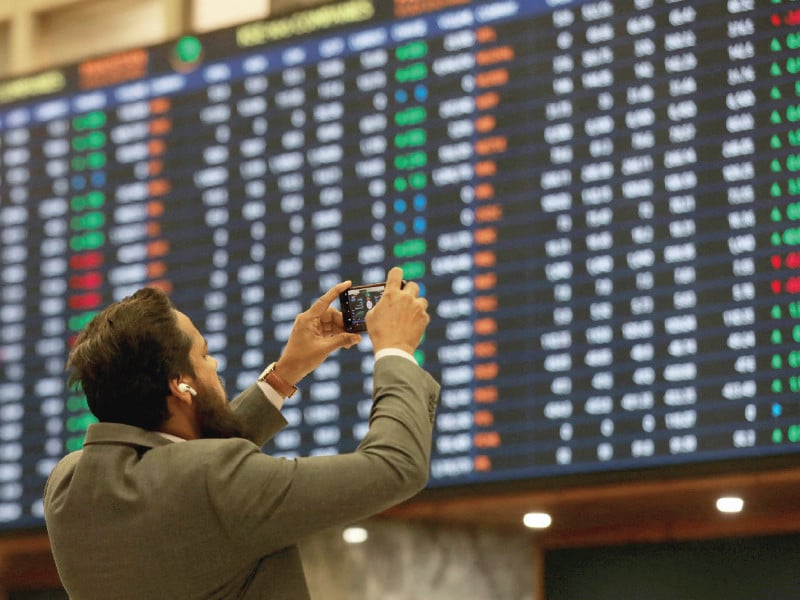
Lost within the noise of new International Monetary Fund (IMF) programme, political instability and tragic security incidents, is the case of Pakistan’s rising stock market.
Very quietly – from its own standards – the KSE-100 index has increased nearly 75% from 40,000 points seen almost a year ago. This is increasing the confidence of a very small segment of society benefiting from the resurgence and some foreign investors as well. But is it as rosy as it seems?
One must always begin discussion on the stock market with the true intrinsic valuation of the index. The most plausible and well-appreciated ratio in this case is the price-to-earnings (P/E) multiple – price being the market value of overall index constituents or the company divided by its earnings or profitability.
Based on various estimates, the one-year forward P/E of KSE-100 still languishes near 4.3-4.5x, which is much lower than the last decade’s average of 8x. Does that mean there is more upside?
Probably yes. Index levels increase due to rising share prices buoyed by growing profitability and also due to increasing dividends. Thus, if company X pays dividend and the price falls, the index value doesn’t decrease while prices usually catch up to reflect the future present value of cash flows.
Such is the calculation in simple language for the total return index (price plus dividend). So, if anyone gives you a 12-month target of 85k for KSE-100, you should know that it is a composite of 11-12% earnings growth and 9-11% dividend yields. Forget about buying shares at “historic high rates”.
Investing in the stock market should not be a way to make quick bucks or become rich overnight. It requires a much careful consideration in terms of defining your risk appetite, invested time horizon, cash flow needs and the amount of capital.
Always question yourself what percentage of your personal wealth can you park for long term? Young to middle-age men and women must put 20-50% of their assets in equity securities, which have over long term given better returns than investment in property or plots.
Is the boat missed? Not necessarily. While seeking your brokers or investment advisers’ opinion, always be wary of the conflict of interest.
A broker making you trade frequently may not be a well-wisher as he gets a cut. A fund manager mimicking the index is securing his 2-3% management fee without taking bets.
It’s important to align the interest with people by sharing profits with them and also putting clawback or minimal loss sharing to feel the same. Then only will you be guided to diversify across companies, industries, limit your exposure to one stock, avoid taking leverage, assessing penny stocks and avoiding “tips” from big boys.
The regulatory regime has drastically improved over a decade or so. Right now, everyone has access to information at the same time (though some insiders may persist) via prompt dissemination of company’s results and material notices on the PSX and frequently conducted analyst/investor briefings.
Previously, brokers would call their selected clients with priority to relay key information, but now research reports and other public news are available on every WhatsApp group along with noisy voice notes which should be ignored.
While there is no formula for making money from equity securities, it is extremely important to show respect to market forces. Always you must know what are short-term, imminent macro triggers for a company and the country?
Always read financial accounts, analyst briefing notes and research reports from analysts. Do not forget to compare apples vs oranges vs pears. Check how did the company perform previously under similar circumstances and how have the environment changed since then.
For example, the KSE-100’s 8x P/E might be long term when interest rates were 10-11%, in a 15-17% interest rate scenario 6-6.5x P/E may be the new average.
In the next 12 months, the market re-rating and growth would be guided by falling interest rates, making equity markets attractive, key reforms under the new IMF programme determining sectoral growth and macro de-risking, government ability to increase exports and tax-to-GDP ratio to avoid debt-induced boom and bust cycles of 2018 and 2022, structural reforms in the power sector to make it sustainable and incentives given to listed companies vis-a-vis real estate and savings accounts.
Never forget that at the distressed valuation – when everyone was worried about default – the ambiguity is there but there is easy money on the table. You only need to monitor, wait and hope for economic stability to re-rate the market.
The difficult job of stock selection would be the second stage. If the government increases taxes on real estate, savers start getting lesser in bank accounts, the rupee remains stable to reduce returns by keeping dollars, low commodity prices give impetus to cyclical sectors and youth starts trusting the stock market as a means of savings in such a digitally enabled environment, there is no reason why the KSE-100 cannot go beyond 100k in 2025. Do your research, invest carefully, think long term and don’t trust everyone.
The writer is an independent economic analyst
Published in The Express Tribune, April 22nd, 2024.
Like Business on Facebook, follow @TribuneBiz on Twitter to stay informed and join in the conversation.
























COMMENTS
Comments are moderated and generally will be posted if they are on-topic and not abusive.
For more information, please see our Comments FAQ